In the world of digital marketing, data is king. It provides valuable insights into the performance of your website, allowing you to make informed decisions and optimize your strategies. Google Analytics is a powerful tool that helps you analyze this data and understand your audience better. It’s crucial to grasp the concepts of metrics vs dimensions to harness the full potential of Google Analytics. In this article, we will explore what metrics vs dimensions are in Google Analytics, how they differ, and their significance in tracking and measuring your website’s performance.
Metrics vs Dimensions in Google Analytics
In Google Analytics, understanding the metrics vs dimensions is crucial for effectively tracking and analyzing website performance. While metrics vs dimensions provide valuable insights, they serve different purposes and offer distinct perspectives on user behavior. Don’t forget to check how to create automatic charts with Google Sheets Explore.
Understanding Dimensions in Google Analytics
Dimensions in Google Analytics are attributes or characteristics of your data that provide additional context and information about user behavior on your website. They help you categorize and segment your data into meaningful groups, enabling more profound analysis and understanding. Dimensions answer questions related to the “what” aspect of your data. Dimensions allow you to filter and dissect your data, providing insights into user segments and their behaviors. Don’t forget to check Google Analytics goals. Here are some common examples include:
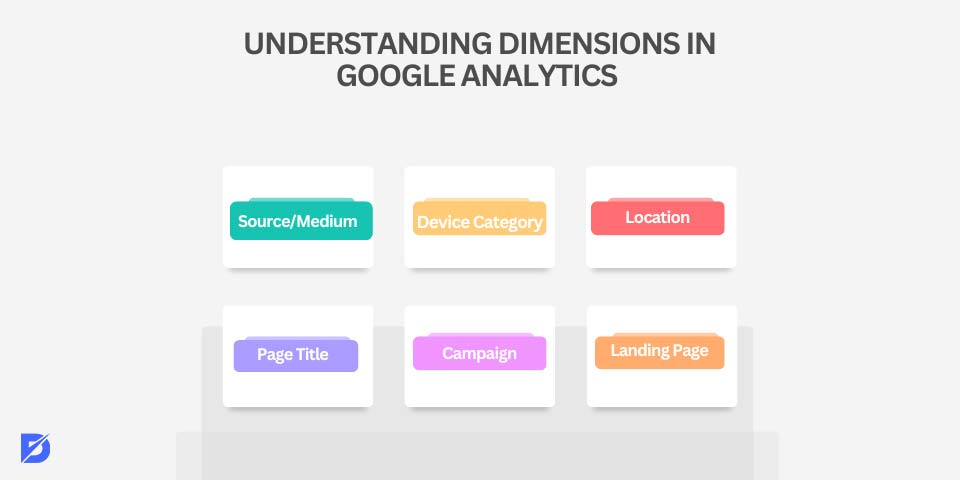
- Source/Medium: This dimension reveals where your website traffic is coming from, such as organic search, referral links, social media, or paid advertisements.
- Device Category: It categorizes the devices used by your website visitors, including desktop, mobile, or tablet.
- Location: This dimension provides information about the geographic location of your website visitors, including their country, city, or region.
- Page Title: It represents the title of the specific web page users visit.
- Campaign: This dimension represents the title of the specific web page users visit. It helps you understand which pages attract the most attention and engagement from your audience.
- Landing Page: It identifies the specific page where users entered your website. It helps you analyze the effectiveness of different landing pages in capturing user attention and driving conversions.
These are also examples of primary dimensions, the foundational dimensions that form the basis of your analysis. These primary dimensions serve as the building blocks for analyzing and understanding user behavior on your website in Google Analytics. They enable segmentation, filtering, and combination with metrics and secondary dimensions to gain deeper insights into your audience and optimize your digital marketing strategies.
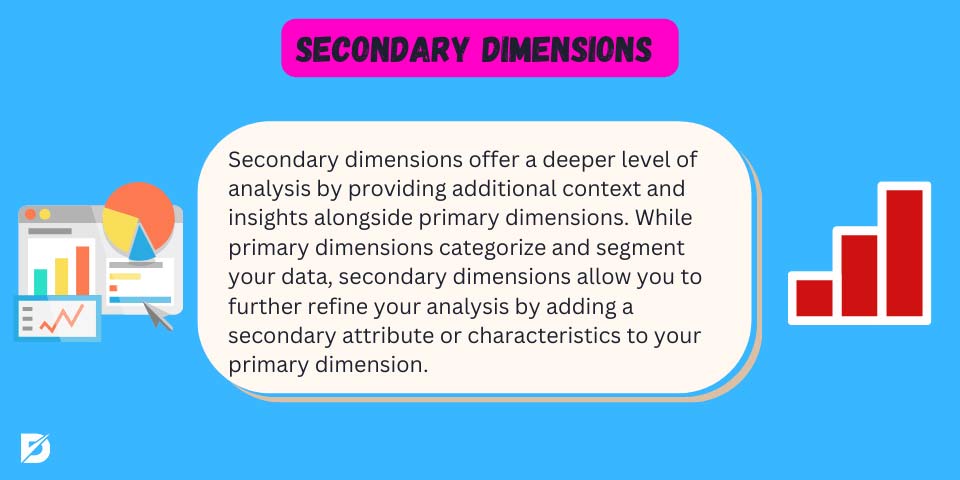
Secondary Dimensions
Secondary dimensions offer a deeper level of analysis by providing additional context and insights alongside primary dimensions. While primary dimensions categorize and segment your data, secondary dimensions allow you to further refine your analysis by adding a secondary attribute or characteristics to your primary dimension.
Secondary dimensions provide a more detailed perspective and help you uncover relationships and patterns within your data. They offer a way to explore the “what” of your primary dimension in conjunction with another dimension. By adding a secondary dimension, you can gain a richer understanding of user behavior and make more informed decisions.
For example, if you analyze website traffic by source/medium (primary dimension), you can add a secondary dimension, like the device category. This combination allows you to see not only where your traffic is coming from but also the specific devices users are using to access your website. This information can be valuable for optimizing your website’s responsiveness and user experience across devices.
Here are some examples of secondary dimensions in Google Analytics:

- Age: This is a secondary dimension that can be added to the primary dimension of User Gender, providing insights into the age demographics of your website visitors.
- Device Category: When added as a secondary dimension to the primary dimension of Source/Medium, it helps identify the specific devices used by users from different traffic sources.
- City: Adding this secondary dimension to the primary dimension of the Country provides a more granular view of the specific cities from which your website visitors originate.
- Page Title: When used as a secondary dimension alongside the primary dimension of the Landing Page, it helps identify the specific page titles of the landing pages that users interacted with.
- Source/Medium: By adding this secondary dimension to the primary dimension of the Campaign, you can analyze the specific traffic sources and mediums that contributed to the success of your marketing campaigns.
- Language: This secondary dimension can be added to the primary dimension of Location to gain insights into the languages your website visitors prefer.
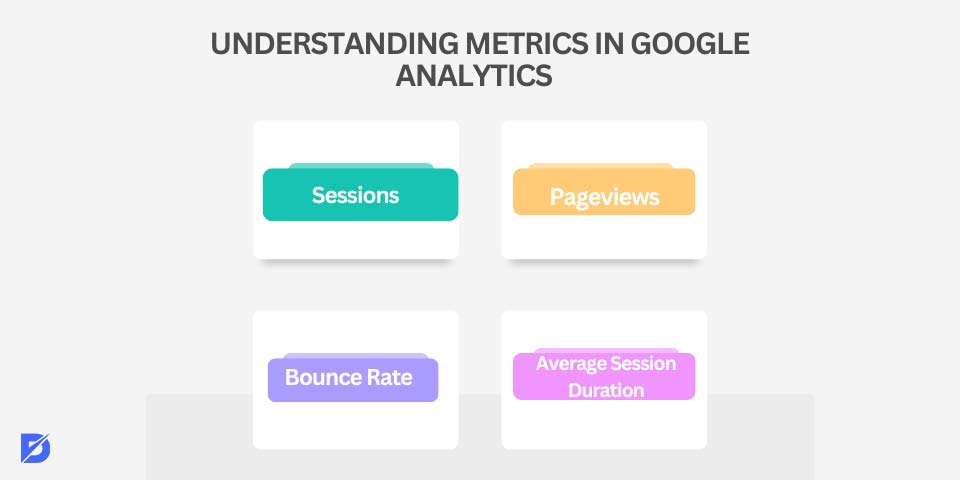
Understanding Metrics in Google Analytics
Metrics are quantitative measurements derived from your data. They represent numerical values that help you analyze and quantify user behavior on your website. Metrics answer questions related to your data’s “how much” or “how many” aspects. Common examples of metrics include sessions, pageviews, bounce rate, and conversion rate. Metrics provide a quantitative assessment of your website’s performance and serve as benchmarks for evaluating the success of your marketing efforts. You may also be interested in how to create digital marketing reports using Google Data Studio. Some commonly used metrics include:
- Sessions: This metric, this metric represents the number of user sessions on your website. It gives you an overall count of how many times users visited your site.
- Pageviews: It counts the number of times a particular web page is viewed by users, providing insights into your content’s popularity and engagement level.
- Bounce Rate: This metric measures the percentage of users who leave your website after viewing only one page. It helps you assess the quality and relevance of your content.
- Average Session Duration: It calculates the average time users spend on your website during a session, indicating user engagement and content consumption.
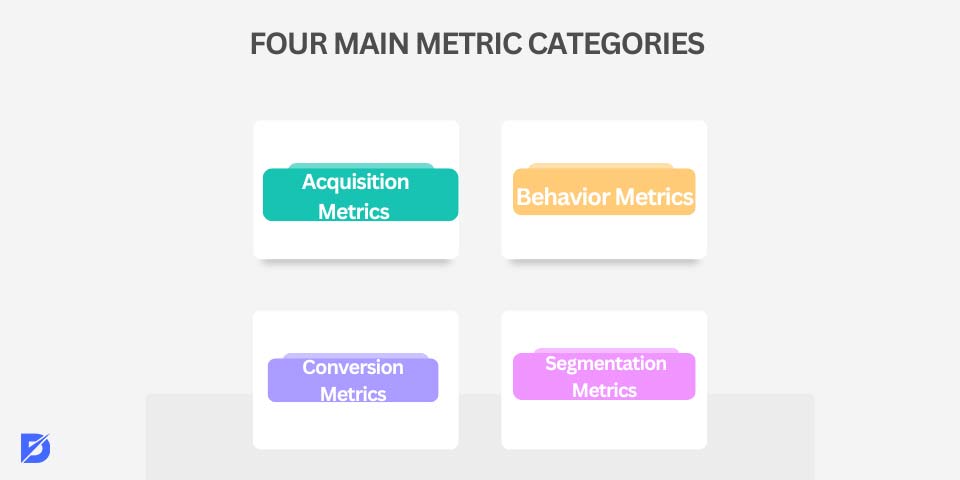
Four Main Metric Categories
Metrics in Google Analytics can be categorized into four main categories, known as the “ABCs” of metrics. You can also check Google Ads Editor: what it is & how to use it here. These categories are:
- Acquisition Metrics
- Behavior Metrics
- Conversion Metrics
- Segmentation Metrics
Acquisition Metrics
Acquisition metrics focus on how users find and arrive at your website. They provide insights into the sources of your website traffic and the effectiveness of your marketing efforts. Understanding acquisition metrics can help you assess the success of your acquisition channels and optimize your marketing strategies. Here are some key acquisition metrics:
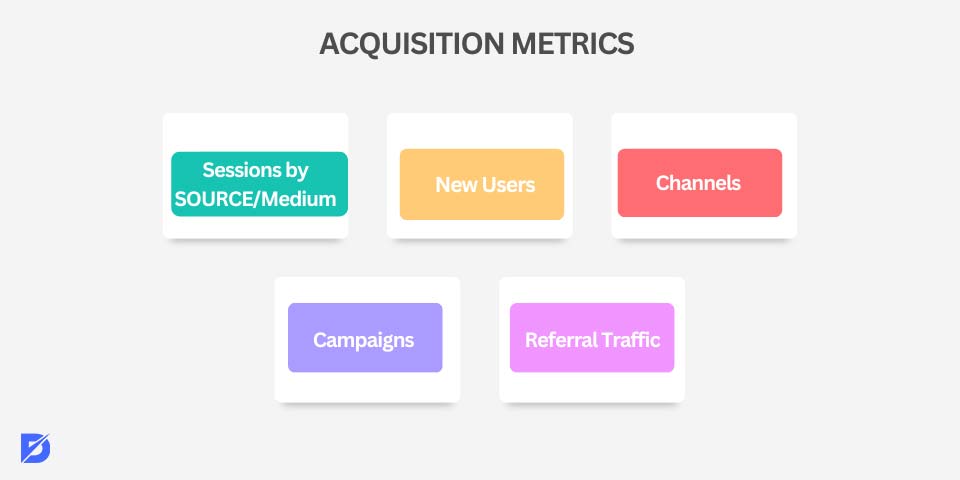
- Sessions by SOURCE/Medium: This metric shows the number of sessions originating from different traffic sources and mediums. It helps you understand where your website traffic is coming from, such as organic search, direct traffic, referral links, social media platforms, or paid search.
- New Users: This metric indicates the number of first-time visitors to your website within a specified time period. The new users metric helps you assess the effectiveness of your audience base.
- Channels: Google Analytics categorizes traffic into different channels, providing insights into how users discover your website. Common channels include Organic Search, Direct, Referral, Social, Email, and Paid Search.
- Campaigns: Campaign metrics track the performance of your marketing campaigns. By using UTM parameters in your campaign URLs, you can measure the effectiveness of specific marketing initiatives, such as email campaigns, banner ads, or social media promotions.
- Referral Traffic: This metric provides insights into the websites that are referring to your website. It helps you identify external sources that are driving visitors to your site, such as partner websites, industry directories, or blog mentions.
Behavior Metrics
These metrics focus on understanding how users interact with your website and their engagement levels. Behavior metrics provide insights into user behavior, navigation patterns, and page-specific interactions. By analyzing behavior metrics, you can identify areas for improvement, optimize user experiences, and drive higher engagement. Here are some key behavior metrics:
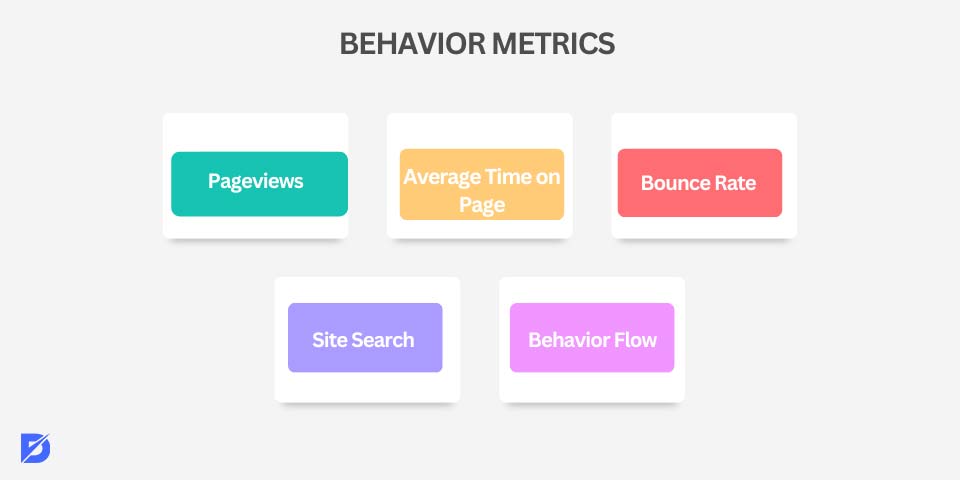
- Pageviews: This metric represents the total number of times a page on your website has been viewed. It helps you understand the popularity and engagement level of specific pages.
- Average Time on Page: This metric shows the average amount of time users spend on a specific page. It helps you gauge user engagement and the level of interest in your content. A higher average time on a page may indicate that users find the content valuable or engaging. In contrast, a low average time on a page may suggest that users are not finding what they are looking for or encountering usability issues.
- Bounce Rate: This is the percentage of single-page sessions where users leave the website without any further interactions. It indicates the level of engagement or lack thereof. A high bounce rate could suggest that users are not finding the information they need, the website has a poor user experience, or the content does not align with their expectations.
- Site Search: If your website has a search functionality, site search metrics provide insights into how users are utilizing this feature. You can track metrics such as search terms, search refinement, and search exits.
- Behavior Flow: Behavior flow visualizes the path users take through your website, showcasing the sequence of pages they visit and the interactions they make. It helps you understand the typical user journey and identify any drop-off points or popular paths.
Conversion Metrics
Conversion Metrics focus on tracking and measuring user actions that are considered conversions or goals on your website. These metrics help you understand the effectiveness of your website in driving desired actions from users and achieving your business objectives. You can optimize your website, marketing campaigns, and user experiences to increase conversions by analyzing conversion metrics. Here are some examples of these metrics:
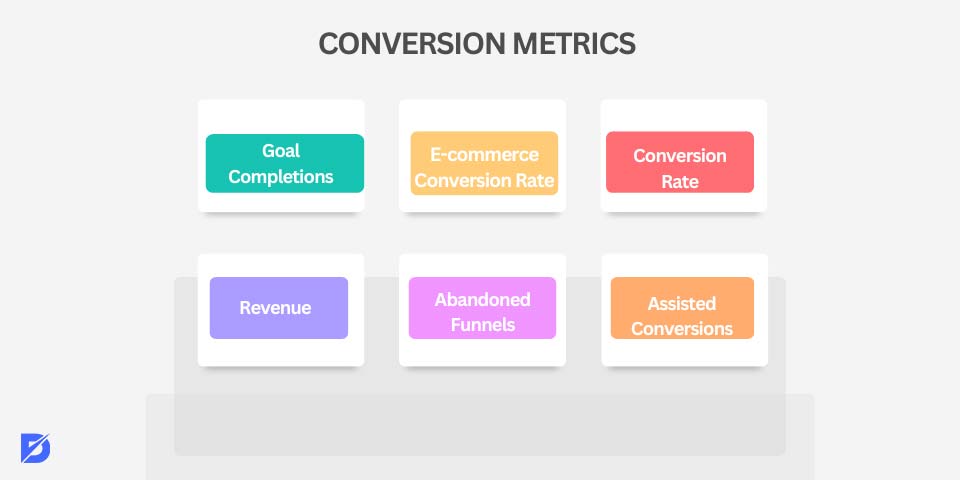
- Goal Completions: Goals are specific actions or milestones you define as valuable conversions on your website. The goal completions metric represents the number of times a specific goal has been completed. Examples of goals include making a purchase, filling out a contact form, signing up for a newsletter, or downloading a file.
- E-commerce Conversion Rate: If you have an online store, the e-commerce conversion rate metric indicates the percentage of website visitors who complete a purchase. It helps you understand the effectiveness of your online sales funnel and the rate at which visitors are converting into customers.
- Conversion Rate: This metric represents the percentage of website visitors who complete a specific conversion goal. It helps you evaluate the overall effectiveness of your website in driving desired actions.
- Revenue: This metric tracks the total monetary value generated from conversions on your website. It is particularly relevant for e-commerce websites where you can assign a value to each transaction. Revenue tracking allows you to measure the financial impact of your conversions and make informed decisions about your marketing and sales strategies.
- Abandoned Funnels: Abandoned funnels metrics help you identify the points in your conversion funnel where users drop off without completing the desired action. You can identify potential obstacles or usability issues that hinder the conversion process by analyzing abandoned funnels.
- Assisted Conversions: Assisted Conversions metric provides insights into the channels and interactions that contribute to conversions but may not be the final touchpoint. It helps you understand the full customer journey and the role of different marketing channels in influencing conversions.
Segmentation Metrics
Segmentation Metrics allow you to analyze your data based on specific criteria or segments. By segmenting your data, you can gain deeper insights into the behavior and characteristics of different subsets of your audience. This helps you understand the effectiveness of your marketing efforts, identify trends, and tailor your strategies to specific segments. Here are some key examples:
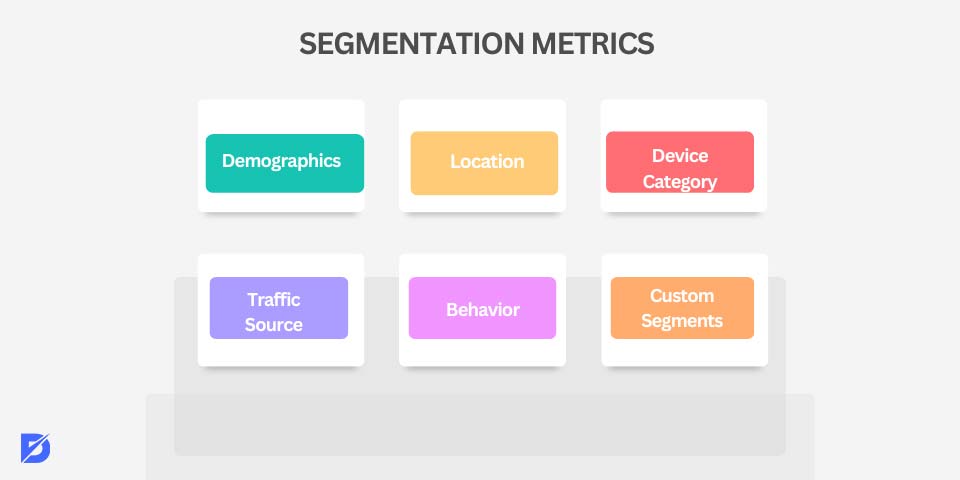
- Demographics: These metrics provide insights into the age, gender, and interests of your website visitors. So, by analyzing demographic data, you can understand the characteristics of your audience and tailor your content and marketing campaigns to specific demographic groups.
- Location: Location segmentation metrics provide information about the geographic location of your website visitors, including their country, region, and city. This data helps you understand the geographical distribution of your audience, identify areas of high or low engagement, and tailor your marketing efforts.
- Device Category: Device segmentation metrics categorize your website visitors based on the type of device they are using, such as desktop, mobile, or tablet. This information is crucial for optimizing your website’s responsiveness and user experience across different devices.
- Traffic Source: These metrics allow you to analyze your website traffic based on the source or channel through which users arrive at your website. This includes organic search, direct traffic, referral links, social media platforms, or paid advertising.
- Behavior: Behavior metrics allow you to segment your audience based on their specific interactions and behavior on your website. For example, you can segment users based on engagement levels, such as frequent visitors, one-time visitors, or returning visitors. You can also segment based on specific actions or events, such as users who have completed a purchase, signed up for a newsletter, or abandoned a shopping cart.
- Custom Segments: Google Analytics allows you to create custom segments based on specific criteria that are relevant to your business goals. These can include various dimensions and metrics combinations to create highly specific segments.
Also, don’t forget to check Google SEO tools, as SEO and SEO tools are important parts of analytics you can check.
Conclusion
In the vast sea of digital data, metrics vs dimensions in Google Analytics are the guiding stars that help you navigate and make sense of the information available. So, understanding the distinction between metrics vs dimensions is vital to effectively harnessing the power of Google Analytics. Hopefully, you understand the details of this informative article about metrics vs dimensions easily!
Frequently Asked Questions About
Yes, you can. You can export the data in various formats, such as CSV or Google Sheets.
Google Analytics offers campaign tracking features that allow you to append specific parameters to your campaign URLs. This also enables you to measure the effectiveness of your campaigns and analyze their impact on your website’s performance.
You can use the “Compare” feature to compare the performance of different segments side by side.
Yes, you can. This allows you to analyze the overlap or differences between segments and gain deeper insights into audience behavior.
A segment is used to analyze data within a defined subset of your audience. On the other hand, a filter is used to permanently exclude or include specific data from your reports. Segments are temporary and can be applied or removed as needed.





No comments to show.